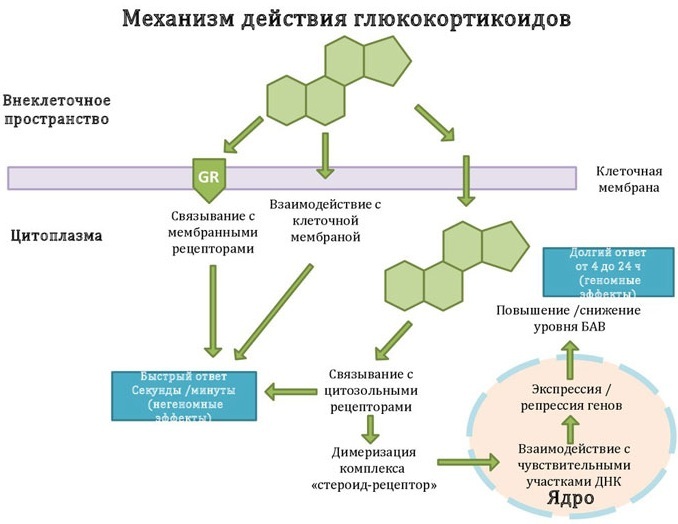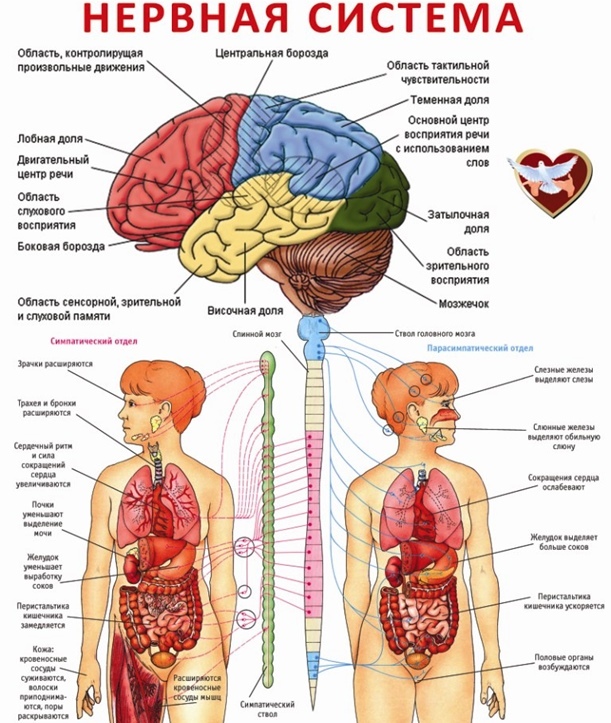Content
- The principle and mechanism of action of tranquilizers
- Advantages and disadvantages
- Indications for use
- Contraindications
- Side effects
- Norms and dosages
- Overdose
- Precautions and special instructions
- The best drugs in the group
- Pills
- Injections
- Infusion / solutions
- Tranquilizer Videos
Tranquilizers are a group of medicinesused for nervous disorders. The drugs are used only according to the indications of the attending physician and under his supervision.
The principle and mechanism of action of tranquilizers
The mechanism of action of tranquilizers is currently not well understood. However, it was found that the drugs have an effect on the subcortical parts of the brain, reducing psychoemotional excitability and anxiety disorder.
The effect of drugs may differ depending on the classification. Thus, it is noted that the entire group has a weak effect on the noradrenergic, dopaminergic and serotonergic systems.
Effects achieved with drugs:
- Anxiolytic - relief of anxiety, psychoemotional stress.
- The hypnotic effect is the normalization of sleep patterns (as a rule, drugs are used as part of a comprehensive treatment for insomnia caused by psychosis or neurotic conditions).
- Sedative - calming effect, lowering the anxiety threshold, relaxing effect.
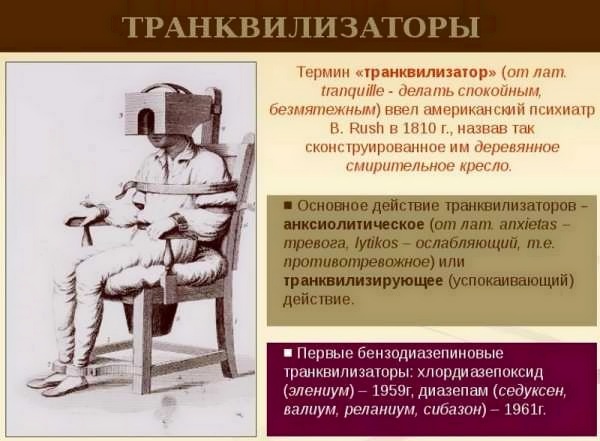
The principle of action of anxiolytics is associated with the suppression of certain structures of the brain - the limbic system, hypothalamus, thalamic nuclei.
In this case, medications affect gamma-aminobutyric acid, enhancing its suppressive effect. Drugs interacting with benzodiazepine receptors leads to their excitation, which leads to the activation of processes associated with the action of GABA receptors. This, in turn, causes inhibition of neurons in the central nervous system.
Benzodiazepine drugs help to eliminate anxiety syndrome, have a sedative, hypotonic and anticonvulsant effect. This group of drugs is highly soluble in fats, therefore it has a high absorbing capacity.
Pharmacological classification and action:
-
Benzodiazepine drugs. The action of the funds is aimed at suppressing the excessive activity of cerebral structures located in the region of the brain. Medicines act locally.
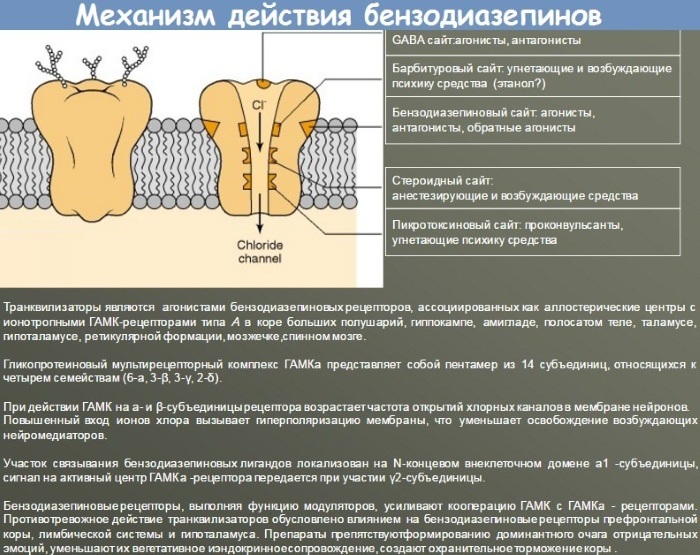
- Definylamine derivatives. They are distinguished by high efficiency and speed of action. However, drugs very quickly form drug dependence in the patient.
- Carbamine ethers. This group of drugs is used in cases where it is necessary to quickly eliminate the acute manifestation of violations. The drugs belong to the ultra-short-acting or short-acting group.
- Others (mixed type of funds). These medicines affect several structures and systems at once.
Also, tranquilizers are divided into several generations - the first, second and third. The most effective and safest (no side effects) are considered drugs of the 3rd generation. However, at the moment, the properties of such funds have not been fully studied.
Advantages and disadvantages
Tranquilizers (indications for use should be checked with the doctor who prescribed the drug) have a number of advantages in comparison with other representatives of drugs that exhibit a similar effect.
Medicines have both pros and cons to consider when using them.
The benefits of anxiolytics include:
- a wide list of indications;
- simple application scheme;
- low toxicity (does not apply to all members of the group);
- affordable cost (in comparison with some other drugs).
Flaws:
- the presence of side effects and contraindications;
- the lack of the possibility of long-term use (dependence develops);
- medications are prohibited for use in the presence of addictions;
- tranquilizers should not be prescribed to children;
- with prolonged use - the development of withdrawal syndrome.
Despite the presence of significant disadvantages, this group of drugs has a pronounced therapeutic effect.
Indications for use
Tranquilizers have an extensive list of recommendations for prescribing, including the symptoms of diseases not associated with nervous disorders.

Indications:
- vegetative-vascular dystonia (VSD syndrome);
- feelings of anxiety and anxiety;
- fear;
- panic attacks;
- various forms of neuroses;
- stressful situations;
- premenstrual syndrome;
- menopause;
- sleep disturbance (insomnia);
- psycho-emotional disorders;
- convulsive syndrome;
- withdrawal symptoms;
- epileptic seizures;
- post-traumatic stress;
- muscle spasms;
- the period before surgical interventions with the obligatory use of anesthesia.
Also, drugs are used for various kinetic disorders - tics, seizures, spasms, hyperkinesia, myoclonus.
Contraindications
Tranquilizers (indications for use are individual for each drug and may differ depending on of the drug used) are prescribed not to every patient, but only after additional research.
Anxiolytic drugs have some limitations that should be considered when using them in some patient groups.
Contraindications:
- intolerance to the components that make up a particular drug;
- the period of pregnancy and breastfeeding;
- myasthenic syndrome;
- renal failure;
- glaucoma;
- liver failure;
- depressive conditions;
- alcohol or drug addiction.

The drugs are also prohibited for use in minors. However, if necessary or according to the indications of the attending physician, this group of funds can be prescribed to children. In this case, treatment should be carried out under the strict supervision of a specialist.
Side effects
It should be borne in mind that this group of drugs can lead to the development of various negative reactions associated with the physiological characteristics of the patient or the action of active components.
Side effects:
- oppression of the central nervous system - impaired coordination of movements, decreased concentration of attention;
- the development of dizziness;
- migraine;
- liver intoxication;
- increased drowsiness and lethargy;
- psycho-emotional disorders;
- muscle weakness;
- feeling of dry mouth;
- high blood pressure;
- deterioration in visual acuity;
- dyspeptic disorders;
- violation of sexual function.
It is also necessary to take into account that tranquilizers, with their prolonged use, can lead to the development of addiction and, after their withdrawal, cause the so-called withdrawal syndrome.
Withdrawal symptoms:
- migraine;
- rapid weight loss;
- agitation;
- increased sleepiness, fatigue;
- tremors in the limbs (tremors);
- excessive sweating (hyperhidrosis);
- sleep disturbance (insomnia);
- irritability;
- convulsive conditions;
- depression;
- impaired perception;
- memory impairment.

When using short-acting or ultra-short-acting agents, these symptoms persist for a day.
Drug withdrawal rules: funds should be canceled only if they are used for more than 2 weeks. When using drugs for 1-2 weeks, signs of pseudosyndrome, as a rule, do not appear.
Thus, when taking tranquilizers from 2 weeks to 1 month, it is necessary to gradually reduce the dosage - half the dose every 3-4 days.
When using medications for several months, the cancellation is carried out in a similar way. However, in this case, the daily dosage should be reduced by no more than 25%.
When using anxiolytics for six months, the dosage is reduced no more than 1 time in 2-3 weeks.
Norms and dosages
Tranquilizers should be used with extreme caution in compliance with all daily dosages. Each drug has its own recommended dosages and indications for use.
Dosages are calculated based on the established form of the disorder and the drug (active ingredient) used.
Preparations and their dosages:
- Hydroxyzine. The drug is made in the form of an intramuscular solution, tablets or pills. The standard daily dose for injection is 25 to 100 mg, divided into several equal doses.
- Diazepam The medicine is made in the form of oral tablets or an injection solution for intramuscular or intravenous administration. Dosages are set individually. Application regimen - no more than 1 time in 2 days and no more than 2 times a week.
- Tofizapam. This medication is available in the form of tablets or injection solution. The standard dosage can range from 50 to 300 mg per day. In childhood, the dosage should be reduced by 2 times. Duration of use - no more than 14 days.
- Clonazepam. This tool is made in the form of tablets or injection solution. Dosage regimen: 1.5 mg per day, divided into 3 equal doses. In this case, the maximum daily dosage should not exceed 20 mg.
-
Phenazepam. A single dose is 0.5 to 1 mg. In this case, the maximum daily rate should not be more than 20 mg. Elderly patients, as well as patients with renal or hepatic impairment, are advised to start treatment with minimal dosages.

Gidazepam is an analogue of Phenazepam - Midazolam. The drug is available in tablet form. Dosage regimen: from 7.5 to 15 mg. It is used for anxiety disorders to promote and normalize sleep.
- Triazolam. This product is available in tablet form. Reception scheme: before bedtime, 1 tablet. Elderly patients are advised to take no more than 1 / tablet.
- Zolpidem. This remedy has a selective hypnotic effect and is produced in the form of tablets. Dosing regimen: take 5-10 mg half an hour before bedtime. Elderly patients are recommended to start therapy with a minimum daily allowance of 5 mg.
The rate of administration and dosage of infusions also depend on the severity of the disorder, the age of the patient and the drug used, therefore, they are calculated individually by the treating specialist.
Overdose
Tranquilizers (indications for the use of funds can be studied independently in the attached to each drug instructions) should be taken only under the supervision of a physician in compliance with all of his recommendations.
If the prescribed daily and single dosages are exceeded, various negative reactions may develop.
Symptoms:
- oppression of the functions of the central nervous system;
- intoxication of the body;
- psychomotor agitation;
- coma;
- death.
With the development of such signs, further use of funds is prohibited until all the components of the drugs are removed from the body.
In cases of overdose symptoms, you should consult a doctor for the appointment and conduct of symptomatic therapy.
Precautions and special instructions
Before prescribing drugs, the patient must be informed that drugs can be addictive and after their cancellation, lead to the development of a withdrawal syndrome, especially after prolonged use tranquilizers.
When taking medications, the dosages prescribed by the doctor or indicated in the instructions should be strictly observed. At the same time, tranquilizers are not recommended to be used on their own without the permission of a specialist.
It is forbidden to use drugs in conjunction with drugs or alcohol, since such a combination can lead to unwanted reactions.
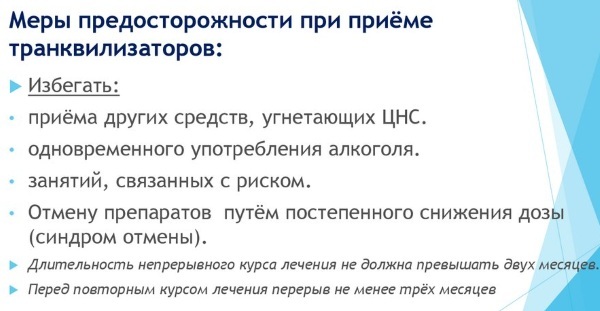
For patients over 65 years of age, the use of medicines begins with the minimum daily and single dosages.
Requires constant observation (including laboratory tests) by the attending specialist for the entire period of use of tranquilizers.
It must be borne in mind that the use of anxiolytics should be carried out in conjunction with other therapeutic methods - psychotherapy, social adaptation.
In the absence of any therapeutic effect within 1.5 months, it is recommended to cancel the further use of medications and prescribe a different treatment regimen.
Cancellation of funds should be carried out gradually according to the recommendations of the treating specialist.
If you experience any negative manifestations, including side effects, you should immediately consult a doctor.
The combined use of tranquilizers and the following drugs should be avoided:
- hormonal agents;
- oral contraceptives;
- MAO inhibitors;
- anticonvulsants;
- anticoagulants;
- antiplatelet agents.
For the entire period of use of anxiolytics, you need to be very careful or refuse altogether. from driving or performing other work requiring high psychomotor and visual functions.
The best drugs in the group
Tranquilizers (indications for the use of the same drug, but several dosage forms can differ from each other) and their dosage forms are selected according to the established disorder in each case separately.
There are several dosage forms of drugs - tablets for oral use, injection solutions and solutions for infusion.
Pills
The most popular form of anxiolytics is tablets. The funds can be produced in the form of capsules, flat tablets or in the form of pills (for oral administration).
As a rule, tablets are used for moderate to moderate neurosis-like conditions.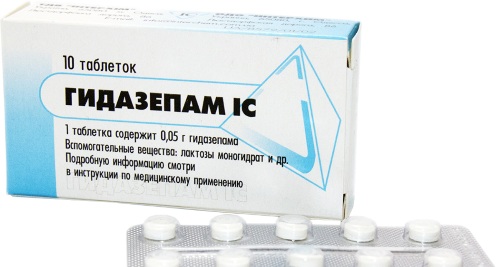
| Name of the drug | Amount in a package | Price |
| Adaptol | 100 tablets | RUB 265-1750 |
| Afabozol | 20 to 120 pcs. | RUB 175-3700 |
| Mebikar | 10 yl 20 pcs. | 80-840 rub. |
| Phenazepam | 7 to 70 pcs. | RUB 96-650 |
| Zolomax | 30 capsules | RUB 500-970 |
| Gidazepam | 20 tablets | RUB 100-300 |
Injections
Injection solutions or powders for their preparation should be used with extreme caution. In this case, the setting of injections should be carried out only by the attending physician in a hospital setting.
| Name of the drug | Amount in a package | Price |
| Relanium | 5 ampoules | RUB 100-120 |
| Tranquesipam | 10 pieces. | RUB 145-175 |
| Elzepam | 5 or 10 pcs. | 120-170 rub. |
| Seduxen | 5 ampoules | RUB 230-350 |
| Sibazon | 5, 10 or 500 ampoules | 70-80 rubles. |
| Relium | 5, 10 or 50 pcs. | RUB 250-500 |
Infusion / solutions
The setting of droppers is carried out only in a hospital setting and is indicated in severe patient conditions or as an emergency treatment.
| Name of the drug | Amount in a package | Price |
| Midazolam | 25 or 60 ampoules | RUB 180-520 |
| Valium | 10 or 50 pcs. | RUB 245-425 |
| Propofol | 1, 5 or 10 pcs. | RUB 340-4930 |
| Oxylidine | 10 ampoules | RUB 245-640 |
| Diazepam | 10 pieces. | RUB 270-350 |
Before using funds belonging to the group of tranquilizers, you must first read the instructions for their use, as well as consult with your doctor.
Tranquilizer Videos
Tranquilizers - what are they, drugs, how they work:


